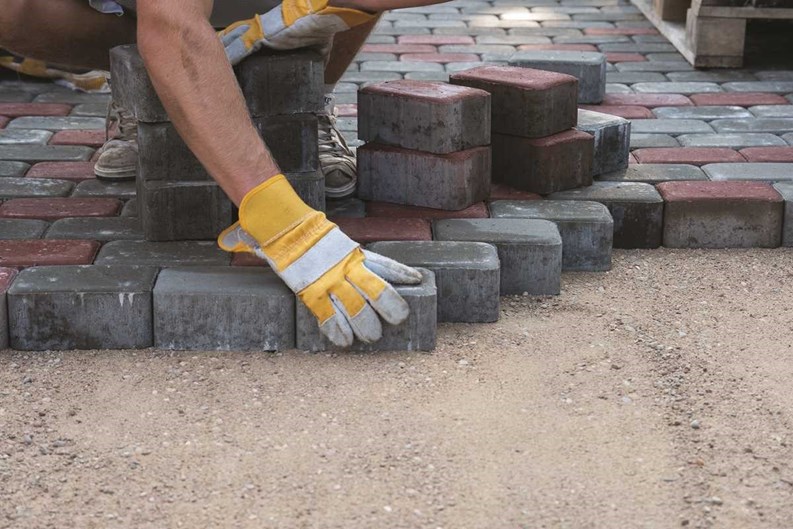When most people think of landscaping, they think of shrubs, trees, meticulously laid-out and maintained flowerbeds, and artful plantings scattered around a building or development. Landscaping doesn’t end with growing things, however—and if you’ve only got grass in your backyard or patio area, you’re missing out on what could be a beautiful feature and selling point in your home. It’s also an alternative way to make your backyard look great while saving yourself time and money if you’re tired of the maintenance that mowing and seasonal yard work takes.
Hardscaping is a term coined to describe non-plant-related landscaping; things like rock gardens, patios and outdoor kitchens, walking paths, terraces and decorative wall elements. Not only are plant-free landscapes an interesting departure from the more traditional bushes ‘n’ shrubs approach, but rocks and paving stones require far less maintenance than a tree or delicate flowerbed, and may represent an opportunity for eventual cost savings for residential complexes or individual homes.
They also offer a nice way for someone to add something a little different to their backyard if theirs is very large.
Casting the First Stone
Before condos and building complexes just jump right in, however, there is more to a hardscape that meets the eye—as in most things. So we grilled the experts to get the dirt on what you need to do when it comes to hardscapes.
First, a word about the definition. Hardscaping is all of your stonework, concrete pavers, travertine, driveways, walkways and edging around the trees. In recent years, with the development of more versatile, permeable hardscaping elements that blend more seamlessly with the living, organic elements, that strict definition has become more blurred. In short, “It’s everything that does not include plant life,” says Lisa Sylvester, office administrator with DiPalantino Contractors (haven’t confirmed her position title) in Doylestown, Pennsylvania.
Just because the definition has broadened doesn't mean just anyone should be installing huge slabs of granite on your condo grounds, however. According to Drew Nicoliello, president of New Jersey Interlock Systems, Inc. in Franklin Lakes, many people call themselves hardscape landscapers, but you need to have the proper home improvement contracting license to officially work as one in the state of New Jersey. In addition to the license, Nicoliello recommends that anyone doing hardscaping also carry adequate and up-to-date workman’s compensation and liability insurance.
And while more traditional landscapers will often take on hardscaping projects, many pros advise hiring a specialist. “We have a horticulturist on staff so that we can incorporate landscaping into our projects,” says Sylvester, “but hardscapes is a trade. It’s a skilled mason.”
Nicoliello agrees. “Landscapers offer hardscape, but you’re better off going to a hardscape landscaper because we’re more knowledgeable,” he says. “I don’t know much about plants but ask me anything about hardstone, and I’ve seen it all.”
There are other reasons to choose your hardscaper carefully. Incorrectly installed, improperly placed stone elements can settle, shift, or otherwise move out of place, and badly poured concrete can crack and heave, or allow water to pool and run off, creating any number of headaches. When this occurs, it can shift or move and damage the hardscape. “We’ve pulled up whole driveways and redone them when they obviously weren't installed correctly,” says Sylvester, “especially since we’re near the water here and things shift underground.”
Having the right tools is also incredibly important, and those tools are expensive—which is why many plant-specialist landscapers and general contractors might not have the correct ones, Sylvester says. “When there are cuts and curves in areas and it’s a little more detailed, you need someone who has the right tools to get the job done,” she says.
A Hard Choice
Quality of materials and workmanship can vary, even among hardscape specialists, so it’s important to make sure your chosen contractor is on point by checking their references and looking them up on a resource like Angie’s List or the Better Business Bureau.
Once you’ve chosen a hardscape landscaper and are comfortable with his or her capabilities and references, the next step is to figure out a design. This is something that the hardscape contractor should also be able to help with.
Nicoliello says he often will discuss the ideas of the homeowner or the building association’s board, and then elaborate on them. Sometimes, he takes the residents to job sites or shows them pictures of finished projects.
Most hardscaping plans are pretty straightforward but for something truly elaborate or technically demanding, it may be necessary to bring in an architect. According to Nicoliello, New Jersey law requires an engineer to get involved if there is a retaining wall 4 feet or higher. When there’s extensive draining, your municipality may also require an engineer.
“We work with engineering companies, especially for drainage,” he says. “In different areas, every project is a little different, so we’ll work with an engineer to see if we need extra drains or a permeable paver to see if the water should seep into the ground as opposed to running off.”
Boards or individuals looking to put in a simple terrace or deck don’t usually need to go through all of that, however, and it’s a much simpler process. That being said, it's still smart to check with the local township, municipality or city to make sure it's okay to undertake the project, as there are sometimes issues with setbacks and other requirements and restrictions, such as size.
A New Approach to Drainage
In recent years, the U.S. Department of Environmental Protection as well as state and local agencies have been promoting low-impact development techniques for storm water management. LID techniques capture water on site, filter it through vegetation, and let it soak into the ground through use of open channels, rain barrels and cisterns, vegetated buffers and swales and rain gardens. The goal is to recharge the local water table instead of sending runoff through pipes and detention basins that ultimately empty into rivers.
Dominic Arangio, the director of business development at a Massachusetts-based landscaping company, describes a project his firm completed using permeable pavers. “We had a field next to a building, that was to be turned into a parking lot using Eco-Stone® … These pavers are thick enough to support vehicles, while allowing storm water drainage through spaces between the interlocking pieces.” The manufacturer claims it infiltrates up to 100 percent of rainfall to recharge groundwater, reducing or eliminating peak runoff as well as pollutants. Eco-Stone is also billed as being snowplow-safe.
Some of these pervious hardscape designs include grasses or groundcover greenery allowed to grow between pavers, so that some lawn care maintenance becomes necessary.
Arangio adds that “Aqua-Bric® is another option where pavers are specified, if it’s an area that needs better drainage qualities, near coasts or shorelines.” The product is designed to form a stable surface that can accommodate pedestrians, wheelchairs and motor vehicles. It allows stormwater to drain through the pavement and infiltrate into the soil below. It can hold up to commonly-used de-icing salts as well as snow removal using shovels, snow blowers or snow plows. The cost is touted as being comparable to conventional poured pavement that would include catch basins, piping and retention basins.
But Arangio cautions, “The success of all these low-impact development options depend on each specific situation… how heavy the foot or vehicle traffic is, local weather extremes, a staff that’s skilled in any special maintenance, and how to monitor that.”
A Rock and a Green Place
There’s also the task of incorporating something like a rock garden or extensive footpath or whatever the hardscape may be into an existing traditional landscaping program. Since organic and inorganic landscaping elements often go together hand-in-hand, this is a key design concept, and it’s important to find a professional who knows how to blend the two harmoniously.
Sylvester says that her company has someone on staff who does this for them.
“We have a designer who is educated in plants and trees and obviously has a paver background, who can mold this together seamlessly,” she says. “We are working on a project where the client is expanding the lounging area around their pool. Hardscaping and [traditional landscaping] are hand-in-hand on this project, because although hardscaping isn’t dealing with plant material, it is changing the shape of the ground, so you’re dealing with the area around the plants and the trees.”
The final consideration is the price. Hardscaping pricing ranges greatly by the job but is usually priced by the square-foot. For terraces in New Jersey, the price is typically between $15-$40 per square foot depending on the material.
Natural stone tends to cost the most, while concrete pavers and bricks cost the least. But using natural stone will not only drive up the cost for material—it will also raise the price for the labor too, Nicoliello says.
Hardscaping costs significantly more money upfront than traditional landscaping does, because the materials cost more. You’re paying for stones, bricks, concrete and other items that cost more than seeds, plants and dirt cost. The cost to transport those heavy items is also more, which brings the price up as well. And since you’re most likely going to be working with someone who specializes in the field of hardscaping, which is a specialty field—the price for labor will be higher too.
But the payoff (in addition to the beauty of the hardscape that you dreamed of) is that the maintenance is significantly less than landscape, and over time, you may even save money if you live in your home long enough to do so. The only maintenance you’ll need to do is to clean and seal the hardscape to help keep its luster. And seeds can embed themselves between the joints over time so it’s recommended to have the pavers cleaned. But pavers are a lifetime investment.
“Maintenance is minimal, and as for upkeep, people will call us every five to 10 years to have everything cleaned and resealed,” Sylvester says.
Brick and stone might need to be cleaned and sealed from time to time, but retaining walls don’t need too much maintenance aside from cleaning once in a while.
That’s all you should need to do as long as you hire a reputable hardscaper so that your hardscape doesn’t crumble and start disintegrating after a few years. It’s a lot less maintenance than weekly lawn mowing, shrubbery cutting and seasonal lawn care. And it always looks clean and tidy.
The only issue that’s recently cropped up is a chipmunk problem. In New Jersey and throughout the nation, chipmunks have been burrowing where the sidewalk or patio meets the home or residential building because the foundation is warm and the New Jersey winters are not.
Chipmunks notwithstanding, hardscaping can be an attractive, low-maintenance alternative to traditional landscaping schemes, both for smaller buildings and for larger HOA communities. Nothing may be cast in stone, but with the right professionals and a good design, your property can look rock-solid.
Danielle Braff is a freelance writer and a frequent contributor to The New Jersey Cooperator.







Leave a Comment